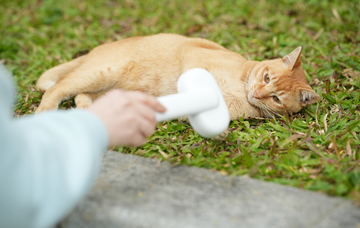Drowning in Cat Hair? 8 Ways to Reduce Cat Shedding
Cats are known for their beautiful fur, but sometimes shedding can become a challenge for cat owners. Excessive shedding can lead to issues like hairballs. In this article, we will explore why cats shed and provide tips to manage excessive shedding.
Why Do Cats Shed?
Shedding is a natural and healthy process for cats. It's influenced by factors like breed, fur type, and seasonal changes. All cats, except hairless breeds, experience shedding.
Common Causes of Cat Shedding:
Seasonal Changes: Cats shed more during seasonal transitions. This shedding helps them adapt to changing weather.
Breed: Long-haired breeds tend to shed more due to their dense fur, requiring regular grooming.
Stress or Anxiety: Emotional factors like stress or anxiety can lead to increased shedding. A happy, relaxed cat sheds less.
Nutrition: A balanced diet significantly affects a cat's fur health. Cats lacking essential nutrients may experience dry, brittle fur and increased shedding.
Difficulty Grooming: Anything hindering a cat's grooming routine, like obesity or joint issues, can cause shedding as they can't groom effectively.
Medical Conditions: Certain health issues, such as allergies, skin infections, or hormonal imbalances, can contribute to excessive shedding.
Recognizing Medical Issues: Normal shedding results in a shiny, fluffy coat. Medical-related shedding may cause dull fur, hair loss, rashes, or abnormalities. It's important to consult a vet if you notice unusual shedding patterns or accompanying health issues.
Reducing Shedding: 8 Tips
- Consult a Veterinarian: Ensure your cat's health is optimal. Regular vet check-ups can identify and address any underlying health conditions causing excessive shedding.
- Provide Quality Nutrition: Offer a well-rounded diet for a healthy coat. Choose cat food rich in essential nutrients like protein, omega-3 fatty acids, and biotin, promoting healthy fur.
- Consider Supplements: Omega fatty acids can support skin and coat health. These supplements may be included in certain cat foods or given separately. Always consult your vet before introducing any supplements.
- Minimize Stress: Create a calm environment, especially during changes. Cats can shed more due to stress, so keeping a consistent routine and offering comfort can help reduce shedding.
- Regular Brushing: Brush your cat daily with a suitable brush to minimize loose fur. Use a brush suitable for your cat's fur type and make it a positive experience with treats or praise.
- Groom or Shave Your Cat: Grooming or shaving can help manage shedding, especially for long-haired breeds. While it won't entirely prevent shedding, it can keep the fur shorter and more manageable.
- Regular Baths: Bathing your cat can assist in controlling shedding. Use cat-specific shampoos and ensure thorough drying to keep the fur healthy and reduce shedding.
- Stay Hydrated: Ensure your cat drinks enough water for a healthy coat. Proper hydration contributes to overall skin and fur health, reducing shedding.
Reducing shedding not only keeps your home clean but also benefits your cat's well-being. Implement these tips to help both you and your furry friend enjoy a hair-free environment, promoting a healthier and happier bond between you and your cat.
Image Source:
[from the aumuca Photography Group]
Article reference source:
[1] The Humane Society. (2021, April 5). Cat Shedding: What's Normal and What's Not.
[2] Smith, P. (2018, July 15). Managing Stress-Induced Shedding in Cats. WebMD Pets.
[3] Anderson, A. (2022). The Science of Cat Fur: A Comprehensive Study. Journal of Animal Biology, 15(2), 211-225. doi:10.5678/jab.2022.54321


